Portable Travel Wifi Device: Review for Digital Nomads
Below is our review of Travel Wifi portable wifi device. We have used the Travelwifi hot spot during our travels as digital nomads, before and after their rebrand from TEP to TravelWifi.
Read on to learn the pros and cons of using this wifi dongle for short-term and long-term world travelers.
Disclosure: This free article contains affiliate links. If you make a purchase after clicking one of these links, we may earn a small commission at no additional cost to you. Your support helps us continue to provide helpful, free content for you. We received a complimentary Teppy pocket wifi device and updated Sapphire 2 wifi travel device to test during our travels. All views in this post are our own.
Updated: November 2022. Originally published: Fall 2017.
Table of Contents
What is Travel Wifi (formerly TEP Wireless)?
Travel Wifi (formerly TEP Wireless) is a global company with a simple mission: to keep you connected to the internet while traveling.
They do this by providing wifi hotspot devices (for rent or purchase), previously called the Teppy, that can be used on 6 different continents as well as islands throughout the Caribbean and beyond.
With the use of the Travelwifi hotspot device, you can purchase data plans and day passes to access data wherever there is coverage.
International Pocket Wifi or SIM Card: Get a wifi hotspot for your trip >
**Save 10% on TravelWifi with our coupon code: INTENTIONAL
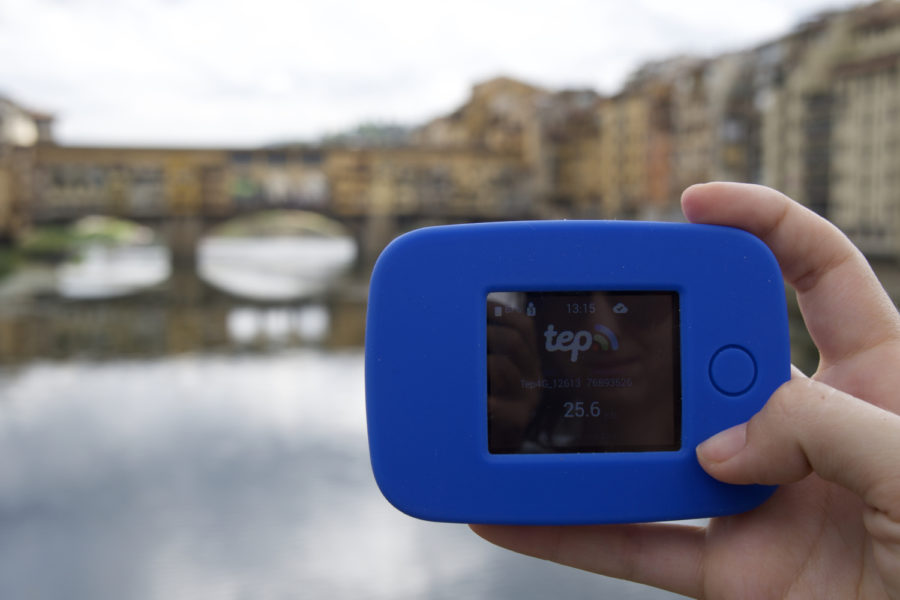 The former Teppy wifi device in Florence, Italy, on our Europe trip
The former Teppy wifi device in Florence, Italy, on our Europe trip
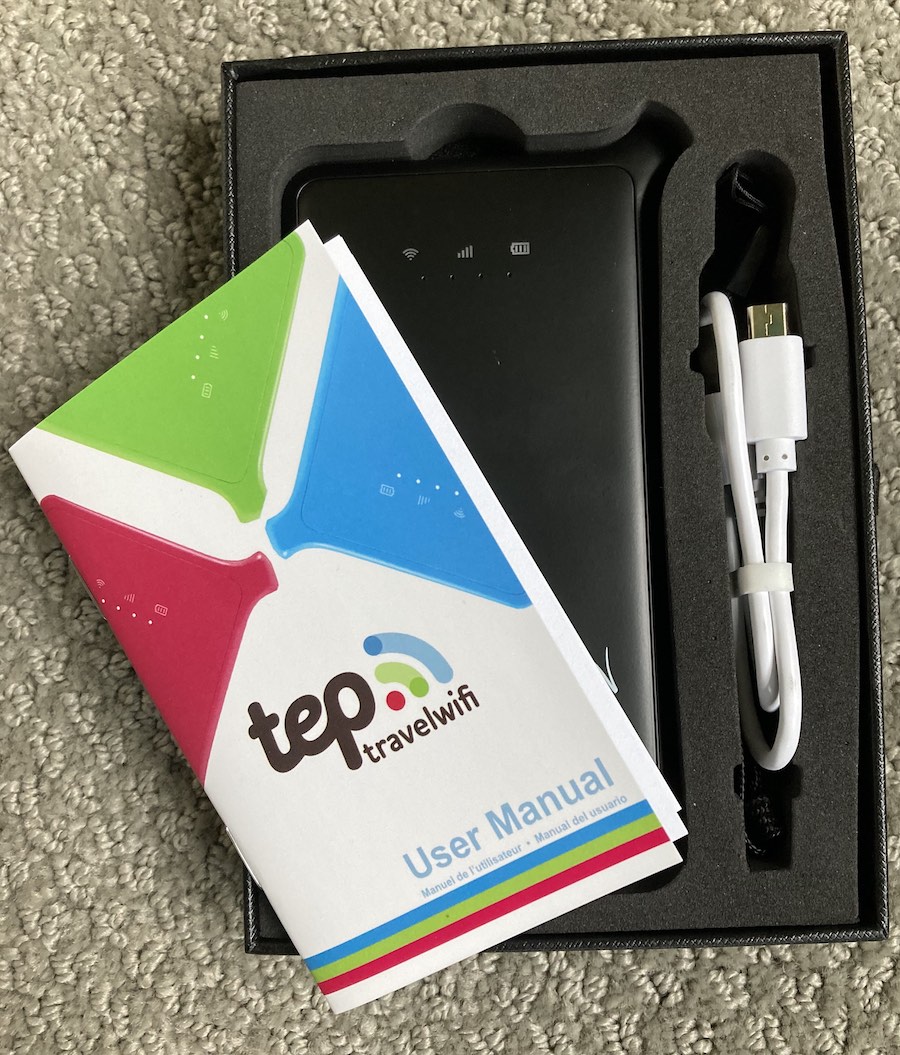 The new Sapphire 2 Travel Wifi device, 2021
The new Sapphire 2 Travel Wifi device, 2021
Here’s what one of our readers recently had to say after trying Travel Wifi:
How the Travel Pocket Wifi Device works
We hope to answer any questions you may have about Travel Wifi in the following video and detailed product review.
Check out the new Travel Wifi device here >
About the wifi devices
The Travelwifi pocket wifi devices are small, portable devices. The standard Portable Hotspot Rental and the Sapphire 2 (for purchase) have one button and one mini-USB charging port.
The Sapphire T2, another option for purchase, has its own 5-inch touchscreen and built-in apps, like Google Maps.
All the devices are the size and shape of a small smartphone with a hard shell exterior.
It’s important to note that the device is not waterproof or water resistant. If you’re really worried about that, you can easily stick it in a ziplock bag or small waterproof sack if needed.
For the purposes of this review, we’ll focus on the Sapphire 2. That is what we have been using and what we recommend for most travelers.
The one and only button on the device does what you’d expect it to do. It turns the device on and off after pressing and holding for three seconds.
The Sapphire 2 should last 12 hours on a full charge. We tested the battery life with fairly regular wifi use all day. After almost 9 hours, the battery light started blinking and showed one of four bars of charge left.
To charge the device, simply plug the mini-USB cord into the Teppy and charge from a USB port. Wall charging is recommended over charging through a computer.
The front of the Sapphire 2 device has indicator lights for Wi-Fi, signal, and battery. Clicking the side power button quickly illuminates the battery life and then then signal strength.
Everything else is managed through the Sapphire app.
How to connect to wireless internet abroad
There is a short set up process in the Sapphire app or the website to create an account, link your device to your account, and manage data plans. This initial set up is best done before you need to use the device, while on another wifi source.
Once abroad, here’s how to connect to the Travel Wifi:
1. Power up the device
2. Select the device’s wifi network on your phone, tablet, or computer
You’ll enter the wifi password, which is printed on the device, just one time for each phone or laptop. After that, you’ll only need to charge the battery and repeat the two steps to reconnect.
Travel Wifi will support up to 5 devices at a time. However, similar to other wifi products, the more devices connected and using data, the slower the performance and data transfer rates will be.
International Pocket Wifi or SIM Card
Get a wifi hotspot for your trip >
**Save 10% on TravelWifi with our coupon code: INTENTIONAL
Travel Wifi Performance
The Sapphire connects on 4G. According to the website, it can reach speeds up to 150 mgps download and 50 mbps upload.
But how fast is this travel pocket wifi in real life?
Teppy Wifi Speeds: Italy, Europe
We tested the older version of the Teppy while in Florence, Italy and were impressed by the download and upload speeds. (Wifi can be notoriously slow in Italy.)
In the most optimal conditions, outside and in an urban city, we were able to see 31 mbps down and 18 mbps.
Comparatively, our Airbnb’s internet was 5 mbps down and .05 mbps up. It was also a glitchy connection that kicked us off every now and then.
The Travel Wifi device was a great back up for us when we returned to Italy in 2022.
Tip: If you’re inside where walls are thick, the signal may not get through very well. We had best results placing the pocket wifi device on a window sill. This allows for a stronger signal from outside while still using a laptop or phone indoors.
Pocket Travel Wifi Speeds: Ecuador, South America

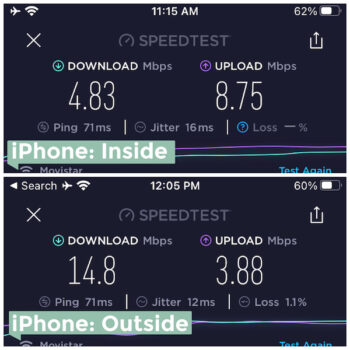
We tested the new Sapphire 2 wifi speeds in Ecuador. Outside in the city, we were able to see 14.8 mbps download and 3.88 mbps upload on our phones.
In our apartment, speeds were 11.47 down and 10.88 up on the laptop. Uploading a 390MB, 2 minute 30 second video to Youtube took about 25 minutes on the hotspot.
For comparison, our Ecuador Airbnb internet in 2021 was among the best in the city: 48 down and 46 up.
Notes About Wifi Hotspot Coverage While Traveling
Because Travel Wifi works using local data networks, you’ll often find that coverage and speeds can be better in more urban areas.
Also, if you’re wondering if they have cruise ship coverage? Only in port and near a major city. You cannot get coverage out at sea or on a plane.
It should also be noted that being inside a building with thick stone walls can also affect coverage. We tested our Teppy inside our Airbnb on the second level of a stone building. The speed was significantly slower inside than putting the device outside on the window ledge or using it outdoors in a clear area of the city.
Does TravelWifi throttle your wifi speed?
Once you use up your daily data amount for the plan you’re on, the device will no longer use 4G. For the rest of the 24 hour period, you’ll connect with speeds up to 256 kbs.
For example, if you’re on the Adventure Plan with 1G per day, your speed will be throttled once you use more than a gig of data within 24 hours of activating the plan. The next day, you’ll go back to 4G speeds.
For the Portable Hotspot Rental, each day resets at midnight GMT. You have until that time to use your daily data amount before speeds are throttled.
Save money, work smarter, travel deeper with
our free Resource Guide for Digital Nomads.
Does the TravelWifi device work everywhere?
Service is provided in over 130 countries. They cover pretty much all of North America, South America, Europe, and Oceana. A large part of Africa, Asia, and the Middle East are covered, with a few more exceptions (see below).
Your pocket TravelWifi will find the best local network in each country. Because it does use local cell phone networks, you won’t be able to get wifi in locations where there is zero cell phone coverage.
If you are traveling to multiple countries, the device works seamlessly within the Global Freedom plan countries.
Countries covered by the Global Freedom plan include:
Algeria, Afghanistan, Antigua & Barbuda, Anguilla, Argentina, Austria, Australia, Aruba, Aland Islands, Barbados, Belgium, Bulgaria, Bahrain, Bermuda, Cambodia, Caribbean Netherlands, Brazil, Canada, Switzerland, Chile, Cameroon, Cayman Islands, Mainland China, Colombia, Croatia, Curacao, Cyprus, Czech Republic, Denmark, Dominica, Estonia, Egypt, Finland, Fiji, France, Germany, Grenada, French Guiana, Ghana, Guadeloupe, Greece, Guam, Guyana, Hong Kong, Haiti, Hungary, Indonesia, Ireland, Israel, India, Iraq, Iceland, Italy, Jamaica, Jordan, Japan, Kenya, Saint Kitts and Nevis, Kuwait, Kazakhstan, Laos, Saint Lucia, Liechtenstein, Lithuania, Luxembourg, Latvia, Morocco, Monaco, Myanmar, Mongolia, Macao(China), Northern Mariana Islands (Saipan), Martinique, Malta, Mexico, Malaysia, Niger, Netherlands, Norway, Nepal, New Zealand, Panama, Peru, Philippines, Pakistan, Poland, Puerto Rico, Portugal, Qatar, Romania, Russia, Saudi Arabia, Sweden, Singapore, Slovenia, Slovakia, South Africa, South Korea, Spain, Sri Lanka, Suriname, El Salvador, Turks & Caicos Islands, Thailand, Turkey, Trinidad and Tobago, Taiwan, Ukraine, United Arab Emirates, United Kingdom, United States, Uruguay, Vatican City, Saint Vincent & the Grenadines, Venezuela, British Virgin Islands, Vietnam
A few countries, like Ecuador, are not available on the Global Freedom plan. However, you can purchase country-specific plans for these instead.
At the time of this writing, some notable countries not covered at all by TravelWifi are: Russia, India, Botswana, Tanzania, Bhutan, Kosovo, Antarctica, Andorra, Israel, Syria, Iran, Armenia, Azerbaijan, Kyrgyzstan, and a few others.
Room for improvement: TEP Coverage and Speed Information
Though I think this is a solid device and service, TravelWifi could still improve on communicating more detailed information about coverage within a given country.
For example, if you go their website and click on “Coverage” in the footer area, it takes you to a page that shows you all the countries that they have coverage. You can click to see the starting rates for data plans in each country, which is an improvement from before.
However, it doesn’t tell you if the country is included in the Global Freedom plans, or if you will need to purchase country-specific data plans.
Another important aspect for digital nomads to realize is that the 4G internet speed is not unlimited. For the average user who is just checking e-mail and looking up things on Trip Advisor, the daily plan limits probably aren’t an issue.
For a pair of digital nomads like us who might need to upload images, do Zoom calls, and work with larger files of content, it is definitely possible to hit the daily data limit. At that point, internet speeds are throttled and heavy online work becomes tedious, if not impossible, for the rest of the day.
For this reason, we tend to use the pocket wifi plans as a back up for working online. It’s handy in case we’re not able to get wifi in our accommodations or a network suddenly drops.
Renting vs. Buying the TravelWifi device
The cost of purchasing a Travel Wifi device is $149-$199, and then you pay on top of that for data packages.
Update: There is now a 5G device with touchscreen as well, which is $399. Sim cards start around $40.
Most frequent travelers buy their own device for convenience.
The rental price is based on the total number of days that you’ll keep the device and how much data you want to use each day. Daily rates start at $6.95.
If you have just one specific trip in mind that’s a week or less, you might as well rent a portable hotspot. However, you may save money by purchasing a device if:
– Your trip is longer than a week or two, OR
– You plan to use more than 2 or 3 GB of data each day, OR
– You’re going to a country with expensive high data, OR
– You could use it on multiple trips
For example, data in Ecuador is unusually high. On a three week trip at 1 GB per day, or a two week trip at 3 GB per day, it starts to be more cost effective to buy your own device.
Best Travel Wifi Review: Final Thoughts
The main things to ask yourself before buying or renting a TravelWifi hotspot are:
– How often do you need to be connected to the internet?
– When and where would you use it?
This is a great device for those that need peace of mind that they can get connected to the internet while traveling.
It’s ideal for urban and semi-rural areas around the world without the hassle of dealing with roaming charges and super expensive international data service plans for phones.
Once you own it, you pay only as needed, and we think that’s an important feature that makes this one of the best travel wifi devices.
This is for you if you’re searching for secure travelers wifi, a portable travel wifi router, a travel wifi sim card or hotspot, or travel wifi rental so you can easily travel with wifi around the world.
Because of the coverage and ease of crossing borders to multiple countries, this works especially great as pocket wifi for Europe. (Plus, if you choose the Europe wifi rental option, you can pick up a device from 50 locations in Western Europe and avoid shipping costs.)
Pros of Travel Wifi
- Better than expected performance in optimal conditions
- Portable
- Easy to set up
- Pay as you go service
- Convenience when visiting multiple countries
Cons of Travel Wifi
- Coverage information isn’t totally clear for some destinations
- Can get pricy quickly if you need to use the device often
By the way, Travel Wifi has regional SIM cards, too. Their current offering seems specifically designed for use in Europe. In addition to 20 GB of data throughout 30 European countries, you also get unlimited calls and texts in Europe for 14 days.
Is the TravelWifi Pocket Wifi Device a good digital nomad wifi solution?
The daily rate can seem expensive for some, but you have to remember that this isn’t necessarily a solution for daily wifi all month long.
In many cases, you will have access to regular wifi from a hotel, apartment, or cafe – the pocket hotspot device would simply fill in the gaps when wifi is not available or when it’s not as strong as you need it to be.
In comparison, T-mobile gave us 2G, or 128 kbps, unlimited data in countries they have partnerships with. That speed is ok for usage on your phone to check email, maybe look at a webpage, etc. However, it’s not great to get any real work done. We could also pay $20 for a 1GB/week pass, but there’s a lot of restrictions there.
The other common alternative is to purchase local SIM cards with a data plan in each country you visit.
This option will often be more affordable, but it does require more effort to set up in each new location. Often you’ll need to bring your passport to a store or kiosk, which takes time. And it may require some foreign language skills.
If you’re moving from country to country frequently and want to avoid the hassle of navigating foreign SIM card situations, the global TravelWifi device would help.
Consider your internet needs as you travel. Do your research and double check TravelWifi’s coverage (as mentioned before). Contact them if needed. You can easily chat with a rep through the website. Compare your own phone service’s rates and plans. You might find this portable device to be just what you need.
International Pocket Wifi or SIM Card:
Get a wifi hotspot for your trip >
**Save 10% on TravelWifi with our coupon code: INTENTIONAL
You might also like these travel gear posts:
– 12 Items We Take With Us on Every Trip
– Digital Nomad Tech Gear Essentials
– My Portable Ergonomic Workstation Set Up for Digital Nomads
Like this post? Pin it for later or share with friends!
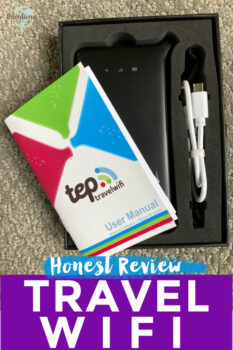

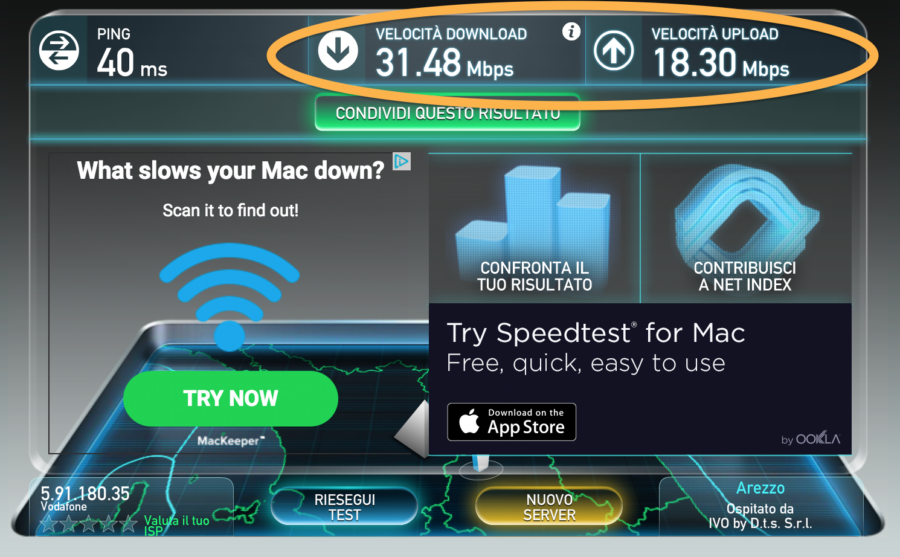
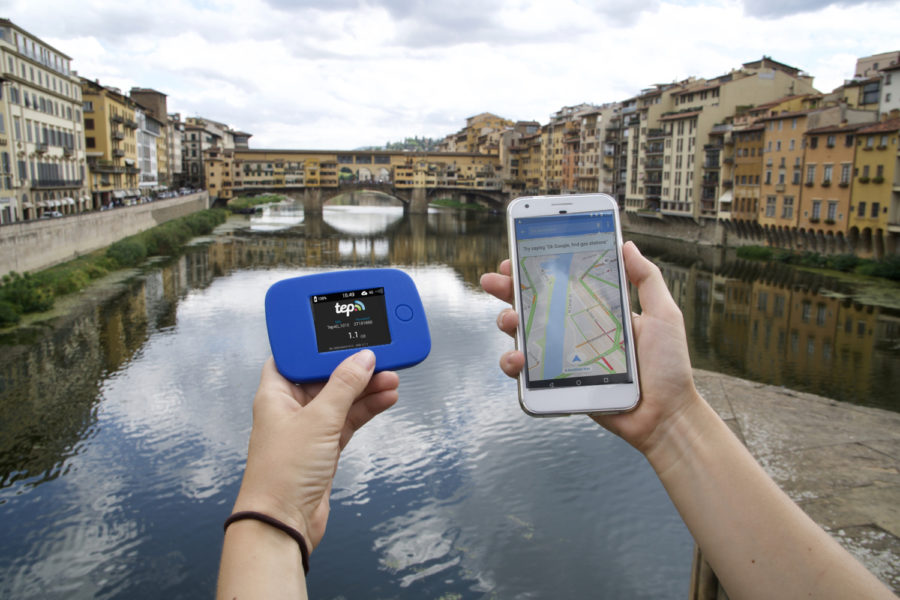
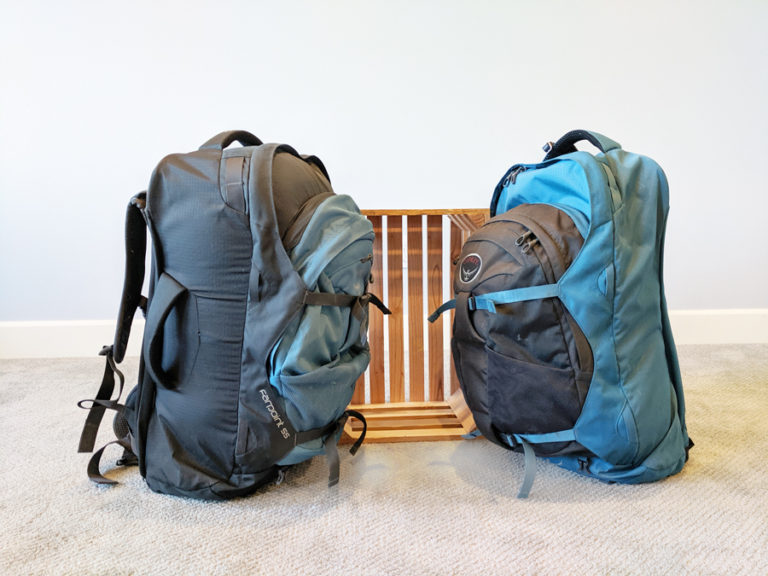





Hi Michelle and Jedd! This gadget sounds very useful. I will have to do more research to see if it is the best solution for our coming travels. Thanks! ~Kathy